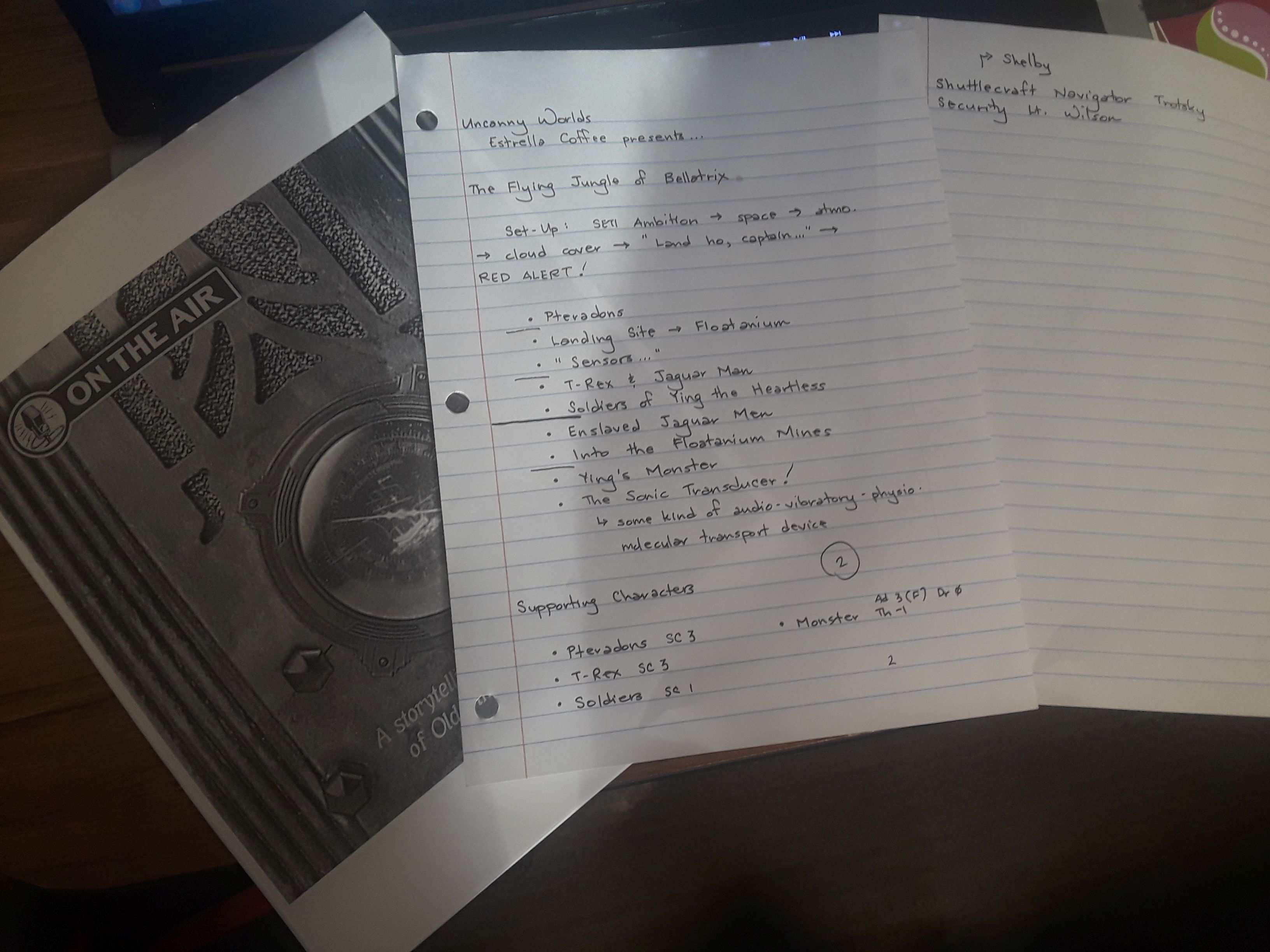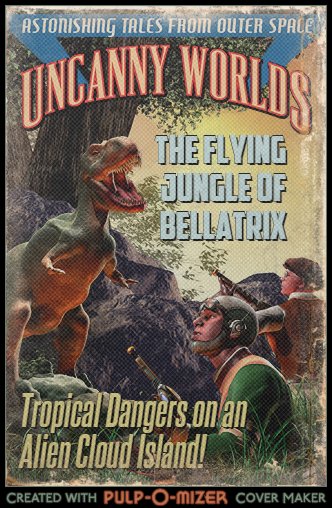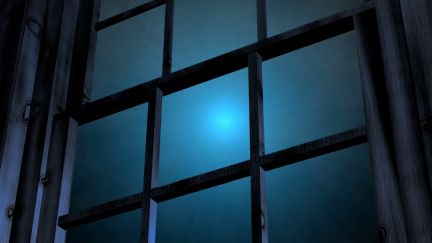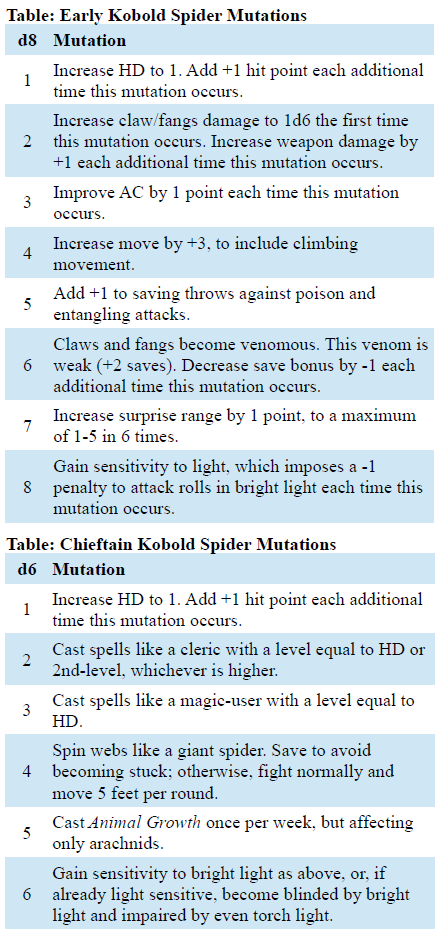On the Air: A Playtest Review
Before we get to the meat of this post, a few announcements.

Most significantly, I’ve resigned from my teaching position. Why? Here’s the short version: The hours I had to work to stay caught up with all the administrative and teaching duties caused sufficient stress that my health suffered. The most bothersome signs were the almost-daily migraines and the hypertension-levels of blood pressure. I’m not a young man any more, and the one heart attack I’ve had was one too many. Of course, I’m not pleased with having to leave before the end of the school year, but the prospect of two months more of pain, dizziness, et cetera, was too daunting.
So, for the third time since June 1985, I’m unemployed, but I’m confident that, just like those other times, this too is a temporary setback. In the meanwhile, I’m planning on staying busy. Yesterday, for example, I drove my wife Katrina to work, ran some errands with my son Christopher, did some chores around the house, cooked dinner, and so far today, I’ve prepared biscuits and sausage gravy for breakfast and typed this post.
Later today, I’ll attend daily Mass at Our Lady of Walsingham, do a few more chores, probably go with Katrina to the gym after she gets done with work for the day, and try to get caught up on a few writing projects, first of them being Dangerous Monsters 3.
And, the last announcement: My son Christopher has a part in a university stage production of Pride and Prejudice, and rehearsal this Saturday takes him out of the DM chair for our ongoing 5E D&D adventures in and around The Village of Hommlet. The rest of us plan on gaming. I’ll be running Save Innsmouth: A Student Documentary for The Cthulhu Hack, doing it in a style somewhere between Memento and Friday the 13th.
And now for some proper gaming content!

Do you like the radio dramas of the early decades of the 20th century? Have you dreamt of a roleplaying game designed to emulate the radio drama genre? If so, then you owe it to yourself to checkout On the Air by Spectrum Games, which can purchased for a mere $4.95 from DriveThruRPG.
I had three players: Christopher, Terry, and new guy Leroy (which makes him the first actual Leroy I remember ever meeting). On the Air (or OtA hereafter) instructs the Director (read: gamemaster) to design a series, complete with a sponsor, a small cast of primary characters (PC), and however many supporting characters (SC), recurring or not, that fit the narrative. I completed the all of the above except for the SC, which we more or less made up on the fly during the game. You can admire my game prep and in-game notes in the pic below.

The series was Uncanny Worlds, sponsored by Estrella Coffee, and the episode title was “The Flying Jungle of Bellatrix”. The main cast of characters was Captain James Augustus Church, Lieutenant Commander Doctor Lana “Brains” MacAvoy, and Technology and Science Android XJ14 (TASA, for short). You can see the PCs here. Christopher played “Brains”, Terry played TASA, and Leroy played Captain Church.
The set-up introduced the episode by title, plugged the sponsor, and then described how the shuttlecraft from Space Exploration Teams Incorporated space rocket Ambition descended into Bellatrix’s atmosphere, heading to the largest of the famed flying jungles in a search for valuable deposits of floatanium, a rare anti-gravity element essential to space travel. Just as Shuttlecraft Navigator Trotsky announced, “Land ho, Captain!”, the shuttlecraft’s klaxon blared. A monstrous pteradon roared out of the clouds, claws extended, intending to prey on the shuttlecraft.
Which brings us to OtA‘s central mechanic: the Intention.
The players decided that they wanted to evade the pteradon while firing blasters out a porthole as the shuttlecraft came in for a safe landing on the flying jungle. In a traditional RPG, this would most likely be played out round-to-round, involving various skill checks and attack rolls. Not so with OtA. With the Intention system, what’s important isn’t the journey, but the destination. Everything is resolved with a single roll of the dice, and the results are narrated radio-drama style.
If you looked at the characters, you noticed they have three ability scores: Adventure, Thought, and Drama. Each score is rated, usually between -1 and 2 (but rules do include the possibility for higher ratings for super-heroics). Here’s where we hit our first foggy area in the rules, which seem to written based on the assumption of one Director and one PC.
The PC with the Intention figures out his total score based on the appropriate trait, perhaps tagging a Descriptor (such as Church’s “Former Space Soldier”). The total score may be adjusted by the opposition of an SC (such as the pteradon, which I arbitrarily decided was SC 3). Since multiple players described how their characters helped, I allowed multiple ability scores to determine the group’s total, and then reduced that total by 3 to reflect the difficulty of the encounter. One player then rolled the number of dice as shown on the “How Many Dice Do I Roll and What Do I Keep?” table. The total, which may be adjusted by Airwave Tokens (more on these later), is checked against the “Intention Results Table” to determine what happens.
An episode (read: adventure) has a time limit, which is defined by a certain number of Intentions. Since our series Uncanny Worlds has a broadcast time of 30 minutes, the episode is limited to 10 Intentions, which means the players get to roll the dice 10 times during the course of the game. Once all 10 Intentions have been used, the episodes ends, perhaps in a cliffhanger (as happened in our game session). Keep in mind that the 30 minute broadcast time is a narrative fiction; it’s not the length of the game session itself, which for us ran to about 4 hours with quite a lot of hemming and hawing and goofing off.
The “Intention Results Table” will be very familiar to anyone whose played Dungeon World or other games Powered by the Apocalypse. A 2-6 total results in a failure, which is narrated by the Director; a 7-9 means the player chooses between a Controlled Failure (narrated by the player) or a Conditional Success (narrated by the Director); and a 10+ is a Success narrated by the player.

(Nota Bene: The pulp-style cover to the right was made using Pulp-O-Mizer.)
Which brings us to narrating the game. Since OtA emulates radio dramas, everything must be described as if the game had an actual audience of people who can only hear what is happening. This includes the players and Director making appropriate sound effects. OtA has many paragraphs of advice on how to do this, and, at least for our group, it was easier to read about and explain than actually do. We’re programmed for traditional RPGs, where the audience isn’t an imaginary construct listening to the players through a radio, but rather is just the people actually in the room. Several times, we had to remind each other to explain how, say, certain hand gestures or facial expressions would be conveyed to people who couldn’t see them.
Our narrations included using Airwave Tokens to edit the scene, repeated endorsements of Estrella Coffee (almost always delivered in character as part of the episode’s dialogue), and one station break to directly advertise Estrella Coffee (the latter activity earning a Sponsorship Token). Airwave Tokens are like action points or hero points common to many games. They are earned when the Director tags a character flaw, for making sound effects (once per scene), or for being clever and/or true to the genre. Players start with two Airwave Tokens, they’re easy to earn, and the players spent theirs freely for scene editing, power tagging, and boosting.
If a character has a relevant Descriptor to include with an intention, one die in the dice pool gets upgraded to a d8. A tagged flaw reduces one die to a d4. With power tagging, one more die gets upgraded to a d8. The Sponsorship Token was earned for roleplaying the advertising segment, which highlighted the virtues of Estrella Coffee by the primary characters and included the main antagonist saying Estrella Coffee’s noble flavor offended his evil palate. A Sponsorship Token can be earned only once per episode. The rules appear somewhat vague to me about which player, if any, “owns” the Sponsorship Token. We treated it as a group resource. At the end of the episode, Christopher used the Sponsorship Token for an automatic success to save Captain Church.
During the episode, the PCs formed an alliance with the Jaguar Men of Bellatrix to oppose the nefarious forces of Ying the Heartless from the planet Thongu. Ying’s soldiers had enslaved many Jaguar Men, forcing them to work in the floatanium mines. There was trouble with a T-Rex, whose floatanium-infused scales made it remarkably agile. Captain Church and TASA were captured and sent to the mines after a daring attempt to escape by riding swiftly on boaboa birds, a noble effort thwarted by a hypno-cannon. “Brains” was also captured, and taken to the tent of the Thongu captain, who later was revealed to be Captain Church’s long-lost brother Gregory. There were thrilling escapes accomplished by digging through the bottom of the floating island while “Brains” drugged Gregory and used the shuttlecraft to rendezvous with Church, TASA, and many Jaguar Men in the sky beneath the flying jungle.
At this time, the Jaguar Man leader revealed that the Thongu soldiers had a sonic transducer set up to transmit the “heart of floatanium” that enabled the jungle to fly. TASA and “Brains” lead Jaguar Men into the mine to face the giant crab monster guarding the sonic transducer while Church engaged his treacherous brother in single combat. TASA used the sonic transducer to teleport the giant crab to Thongu, but not without TASA being transported as well. Church lost to his brother, but the intervention of the Sponsorship Token changed the narration so that Trotsky came roaring in on the shuttlecraft with Jaguar Men reinforcements from another village, thus saving the day.
The episode ended with a cliffhanger as TASA and the giant crab appeared in the sonic transducer reception chamber within the palace of Ying the Heartless on distant Thongu.
Throughout the episode, there were lots of sound effects, repeated dialogue singing the virtues of Estrella Coffee, and plenty of ham and cheese in the form of overacting and punny quips. We even had a recurring subplot about supporting character Security Lieutenant Wilson’s unrequited love for “Brains” remaining unrequited despite his best efforts to win over the good doctor.
All in all, OtA was great fun. It is rules light, and all of the rules are aimed at emulating the radio drama genre. The only other genre-emulation game published by Spectrum Games I’ve played is Cartoon Action Hour, which is also great fun. I don’t see OtA becoming our main game, but I definitely want to play it again.




